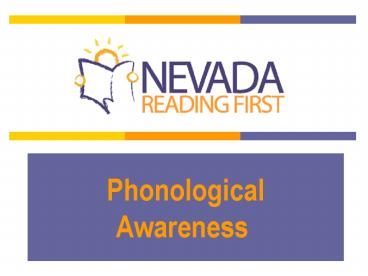Phonological - PowerPoint PPT Presentation
1 / 27
Title:
Phonological
Description:
Rhyme Alliteration. Sentence Segmentation. Syllables. Onset Rime. Phonemic ... Alliteration. Match between the initial phonemes in words. Sentence Segmentation ... – PowerPoint PPT presentation
Number of Views:79
Avg rating:3.0/5.0
Title: Phonological
1
Phonological Awareness
2
Outcomes
- Describe phonological awareness and why it is
important to beginning reading success - Become familiar with documented effective
principles that guide phonological awareness
instruction - Identify principles for assessment of
phonological awareness
3
Clarifying Terms
- Phonological Awareness
- OR
- Phonemic Awareness
4
Phonological Awareness
- . . . the understanding of different ways that
oral language can be divided into smaller
components and manipulated (Chard Dickson,
1999, p 262) - Sentences into words
- Words into syllables
- Onset and rime
- Individual phonemes
5
Phonemic Awareness Falls Under the Phonological
Awareness Umbrella
Phonological Awareness
Onset and Rime
Individual Phonemes
Words into Syllables
Sentences into Words
6
Phonemic Awareness
- . . . awareness of the sounds (phonemes) that
make up spoken words (Literacy Dictionary, 1995,
p. 185) - . . . the ability to focus on and manipulate the
phonemes in spoken words (Report of the National
Reading Panel, 2000, p 2-1)
7
Phonemes
- Phonemes are the smallest units of sound in
spoken words - man has 3 phonemes
- /m/ /a/ /n/
- check has 3 phonemes
- /ch/ /e/ /k/
8
Phonemic Awareness Involves
- Segmenting
- Pulling apart spoken words into sounds
- Blending
- Putting sounds back into words
- Manipulating
- Adding, deleting, and substituting sounds
9
Supporting Phonemic Awareness Development in the
Classroom
- Everybody reads pages 130-135
- Small groups read
- Page 135 Activities that Focus on Rhyme
- Page 138 Activities with Syllable Manipulation
- Page 139 Activities with Onset-Rime Manipulation
- Page 140 Activities with Phoneme Manipulation
10
A Continuum of Difficulty
Phonemic Awareness
Onset Rime
Syllables
Sentence Segmentation
Rhyme Alliteration
(Chard Dickson, 1999)
11
Rhyme and Alliteration
- Rhyme
- Match between the ending sounds in words
- Alliteration
- Match between the initial phonemes in words
12
Sentence Segmentation
- Students count words in sentences
- Students say parts of sentences
13
Syllable Blending and Segmentation
- Blending syllables together to form words
- Segmenting words into syllables
14
Onset-Rime Blending and Segmentation
- In a one-syllable word, the onset consists of the
initial consonant or consonant cluster of the
word - The rime is the vowel and any consonants that
follow the onset
15
Phoneme Blending, Segmentation, and Manipulation
- Blending listening to a sequence of individual
sounds and combining them to pronounce a word - Segmentation breaking a word into individual
sounds - Manipulation
- Add /s/ to the beginning of pin.
- Delete /t/ at the beginning of trap.
- Substitute /i/ in lip with /a/.
16
Practice Activities for Phoneme Manipulation
Say It and Move It Pages 9-10
Elkonin Sound Boxes Pages 11-13
17
What We Know from Research
- Phonological awareness instruction improves
students understanding of how the words in
spoken language are represented in print - Phonemic awareness helps students learn to read
- Phonemic awareness instruction is most effective
when students are taught to use letters to
represent phonemes - Phonemic awareness also helps young students
learn to spell and decode words - National Reading Panel, 2000
18
Grouping for Instruction
- Teach phonological awareness, especially phonemic
awareness, in small groups - Research indicates that small-group instruction
is more effective than one-on-one and whole-group
instruction - Small-group instruction seems to be more
effective because students benefit from listening
to their peers and having more opportunities to
participate - National Reading Panel, 2000
19
Explicit and Systematic Instruction
- Focus on the aspects of phonological awareness
that closely match the types of reading and
spelling of emergent readers and writers - Teach phonological awareness explicitly and
regularly
20
Explicit and Systematic Instruction (cont.)
- Target one type of phonological awareness during
a lesson - Begin with easier activities and progress to more
difficult ones - Model each activity
- Help students make the connection between letters
and sounds as soon as possible
21
Phonological Awareness and Phonics
Phonological Awareness
Phonics
- Phonological awareness helps make the connections
between letters and sounds - Students begin to apply their knowledge of
phonological awareness and phonics during reading
and spelling activities
22
English Language Learners
- Capitalize on native language ability
- Teach blending, segmenting, and manipulating
individual phonemes in syllables - Accept oral approximations
- Focus on words students already know
23
Progress Monitoring
- Monitor each childs progress
- Verify that students are learning
- Results from assessment help make informed
instructional decisions - ELL students may have phonological awareness in
their native language but not English - Difficulty with phonological awareness is one of
the characteristics associated with reading
difficulties
24
Phonemic Awareness Progress Check
25
Keep in mind . . .
- Phonological awareness, especially phonemic
awareness, provides children with essential
foundational knowledge in the alphabetic system.
It is one necessary instruction component within
a complete and integrated reading program. - (National Reading Panel, 2000, p. 2-8)
26
Suggested Reading
- Phonemic Awareness in Young Children A
Classroom Curriculum by Adams, Foorman, Lundberg,
Beeler
- Road to the Code A Phonological Awareness
Program for Young Children by Blachman, Ball,
Black, Tangel
27
Time to Reflect
- One thing Ive learned
- One thing Ill try in my classroom
- One thing Id like to know more about































